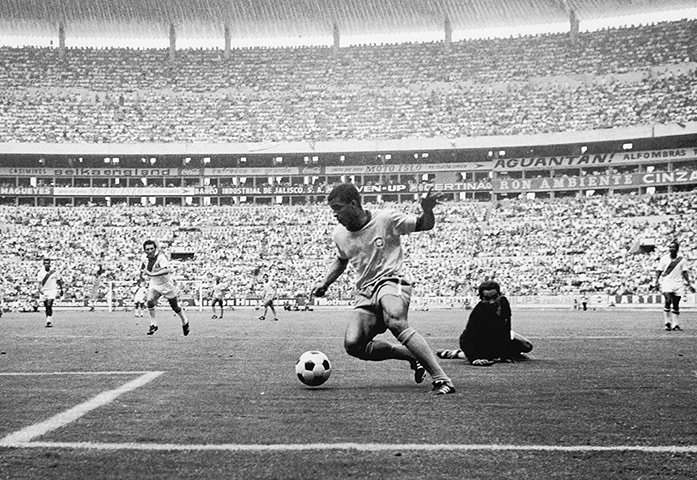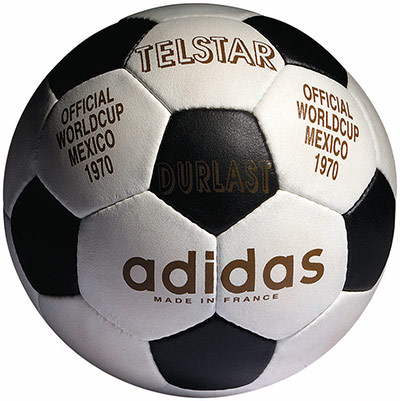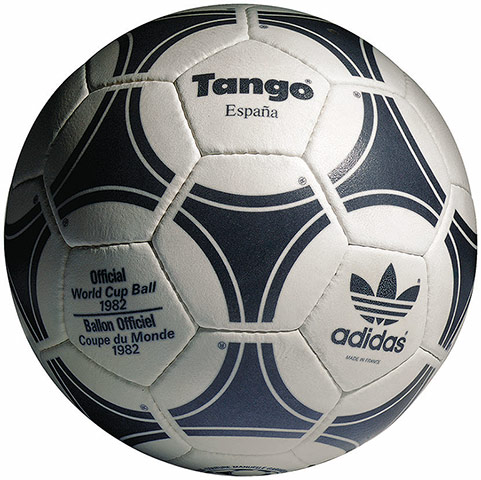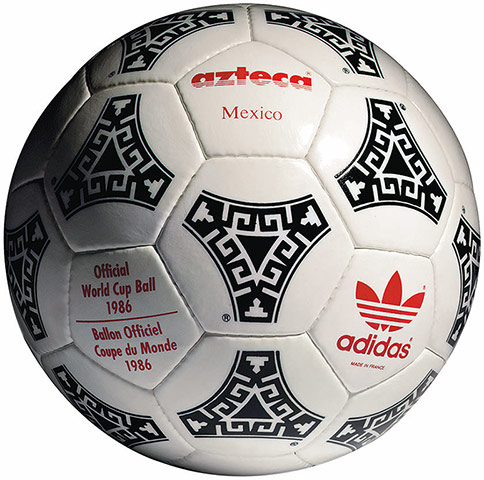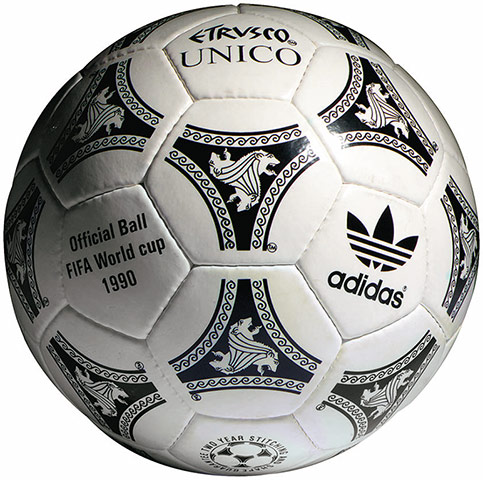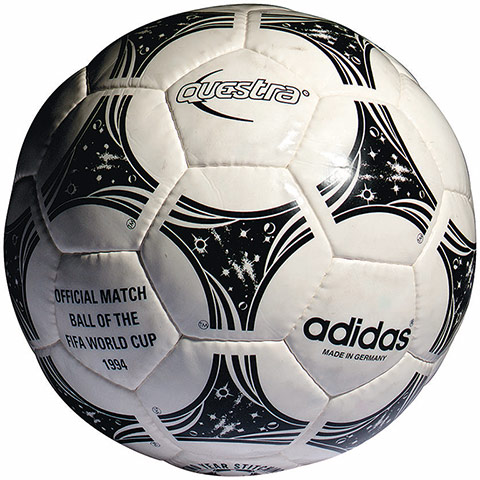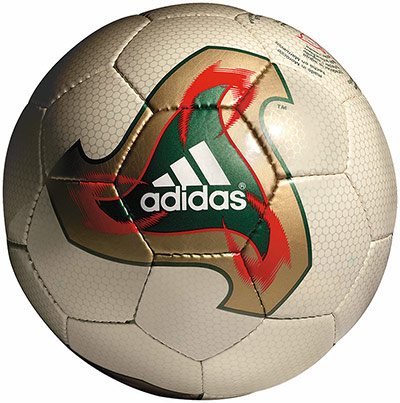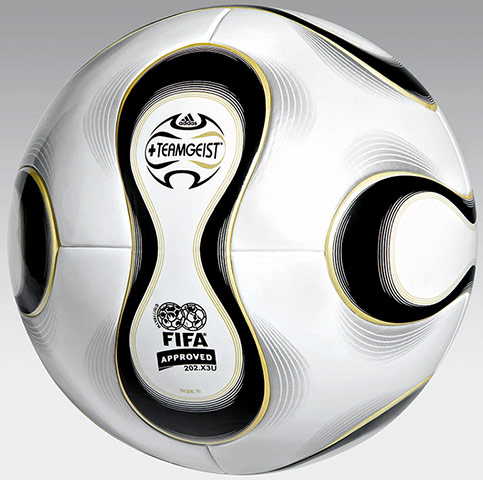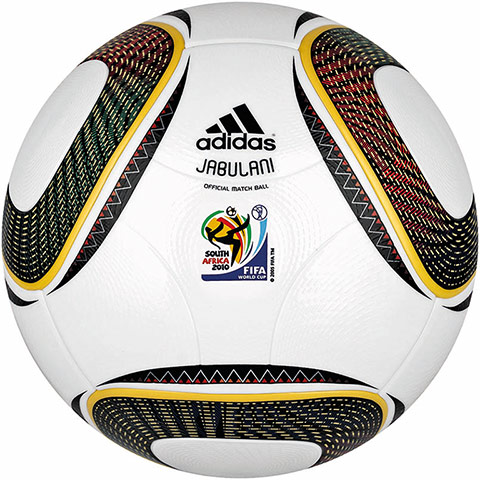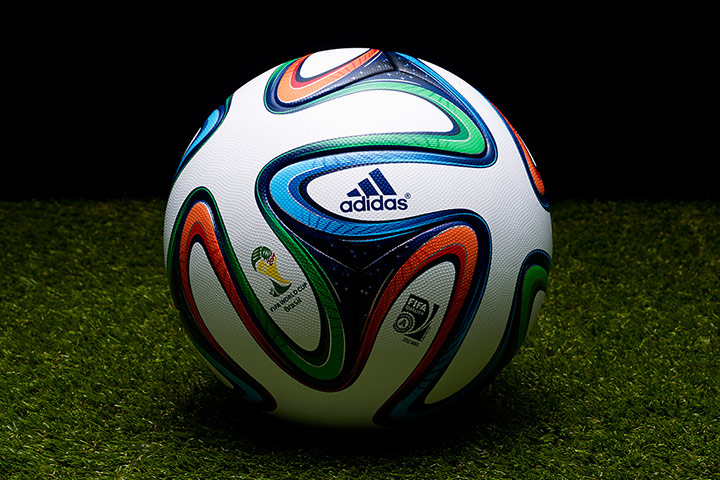- Hata
-
- JUser::_load: Unable to load user with id: 62
 HABERLER & MAKALELER
HABERLER & MAKALELER  Genel
Genel  Diğer Yazarlar
Diğer Yazarlar  Top Deyip Geçmeyin!
Top Deyip Geçmeyin!
| Top Deyip Geçmeyin! |
|
5 Aralık 2013- Futbol topunun gelişimi enteresan bir süreç. FIFA'nın futbol topunun resmi sponsoru Adidas... Adidas 1970'den bu yana futbol topunun gelişimi için yaklaşık 1.8 milyar dolar para harcamış. Size Dünya kupalarında oynanan maçların resmi futbol toplarını aşağıda tanıtmaya çalışacağız.
Mexico 1970 - Telstar The iconic 32-panel ball consisting of black and white pentagons and hexagons was designed for visibility on black and white televisions.
Spain 1982 - Tango España As in 1974, there was little overt design variation of the match ball for the finals, but new waterproof seams reduced the ball picking up water and weight during games.
Mexico 1986 - Azteca The Azteca was the first fully synthetic/polyurethane-coated match ball, and was the first match ball to feature a design specifically inspired by the host nation, with its motif inspired by Aztec architecture.
Italy 1990 - Etrusca Unico Aside from the Etruscan inspired markings on the ball, the Etrusco Unico’s innovations were beneath the surface – an interior layer of black polyurethane foam to improve waterproofing and performance.
USA 1994 - Questra The stars and stripes emblazoned Questra were covered in a layer of polystyrene foam that allegedly made the ball softer to the touch and faster off the foot .
France 1998 - Tricolore The first multi-colored ball (in France’s national colors) — the Tricolore used an advanced print technology for longer-lasting visibility, as well as a new type of foam in the structure.
Korea and Japan 2002 - Fevernova Breaking from the Tango design for the first time since 1978, the Fevernova featured a similar structure as previous balls with an adjustment to the foam structure to improve flight stability.
Germany 2006 - Teamgeist The Teimgeist was a significant structural change to the ball, with a ‘propeller design’ meant to even out variations in how the ball behaved depending on where it was struck (the previous design’s seams and ridges could supposedly influence the flight of the ball if struck first).
South Africa 2010 - Jabulani The Jabulani featured a spherically molded eight panel structure that supposedly made it 'rounder' than previous balls. It also had a 'grip and groove' surface meant to give better contact with the striking boot. The same surface features in the Brazuca.
Brazil 2014 - Brazuca Whilst the technology incorporated into the bladder and carcass of the Brazuca is identical to the Euro 2012 matchball and the Uefa Champions League official match ball, a new structural innovation with a unique symmetry of six identical panels alongside a different surface structure will provide improved grip, touch, stability and aerodynamics on the pitch.
{jcomments on}
|
Degerli yazarimiz Pazartesi, 05 Ocak 2026.
YAZARIN DIGER YAZILARINI GORMEK ICIN TIKLAYIN
- Dünya Kupası: Şikeye karşı FIFA'dan sıkı önlemler (05 Mart 2014)
- Which country has the highest tax rate in the Soccer? (05 Mart 2014)
- Which country has the highest tax rate in the Soccer? (05 Mart 2014)
- Euro 2016 elemelerinde Türkiye, Hollanda ile aynı grupta (24 Şubat 2014)
- M. City model aldığı Barcelona'ya karşı (21 Şubat 2014)
- Fenerbahçe'nin Tahvil İhracına Koşullu izin (18 Şubat 2014)
- Fenerbahçe'nin Tahvil İhracına Koşullu izin (18 Şubat 2014)
- 19.Yüzyılda Futbol Nasıl Oynanıyordu? (18 Şubat 2014)
- Alex Brezilya'da Futbolcuları Greve Götürebilecek mi? (17 Şubat 2014)
- MPs demand football clubs allow far greater supporter involvement (17 Şubat 2014)
- MPs demand football clubs allow far greater supporter involvement (17 Şubat 2014)
- Fenerbahçe'den Yeni Forma Sponsorluk Sözleşmesi (13 Şubat 2014)
- Manchester City reported losses of £51.6m for 2012/13 (30 Ocak 2014)
- Manchester City reported losses of £51.6m for 2012/13 (30 Ocak 2014)
- Manchester City reported losses of £51.6m for 2012/13 (30 Ocak 2014)
- Premier League clubs dominates the international transfer market (30 Ocak 2014)
- Premier League clubs dominates the international transfer market (30 Ocak 2014)
- English clubs were by far world football's biggest spenders on overseas players in 2013 (30 Ocak 2014)
- English clubs were by far world football's biggest spenders on overseas players in 2013 (30 Ocak 2014)
- English clubs were by far world football's biggest spenders on overseas players in 2013 (30 Ocak 2014)
- Para Ligi'nde 2 Türk Takımı (24 Ocak 2014)
- Barcelona'da Kriz: Neymar Transferi İstifa Getirdi. (24 Ocak 2014)
- Barcelona'da Kriz: Neymar Transferi İstifa Getirdi. (24 Ocak 2014)
- A Transformation, Not a Transition, for Manchester United (21 Ocak 2014)
- A Transformation, Not a Transition, for Manchester United (21 Ocak 2014)
- Fenerbahce Boss Links Soccer Match-Fixing Case to Turkey Corruption Probe (21 Ocak 2014)
- Governments Must Do More to Fight Fixing, Say FIFA (21 Ocak 2014)
- Yargıtay Şike Davası'nda Aziz Yıldırım'ın Cezasını Onadı (17 Ocak 2014)
- Futbolda yükselen Arap sermayesi (17 Ocak 2014)
- Milan Eski Oyuncusu Seedorf'u Teknik Direktörlük Görevine Getirdi (17 Ocak 2014)
- Fenerbahçe Spor Kulübü'nün Faaliyet Raporu ve Borç Analizi (10 Ocak 2014)
- Fenerbahçe Spor Kulübü'nün Faaliyet Raporu ve Borç Analizi (10 Ocak 2014)
- Bayern Munich ready to take on Premier League for world domination (10 Ocak 2014)
- Financial Fair Play: Potential Challenges Under and Against the UEFA Regulations (07 Ocak 2014)
- Will Clubs be Banned for not Breaking-Even? A Review of Recent FFP Cases (07 Ocak 2014)
- Will Clubs be Banned for not Breaking-Even? A Review of Recent FFP Cases (07 Ocak 2014)
- Formalar Neden Boş kaldı? (03 Ocak 2014)
- Premier League: January transfer window 2014 - who needs what (03 Ocak 2014)
- Money Buys Soccer Teams, but Not Goals (03 Ocak 2014)
- Chelsea 2013'ü 49.4 Milyon Sterlin Zararla Kapattı (02 Ocak 2014)
- Chelsea 2013'ü 49.4 Milyon Sterlin Zararla Kapattı (02 Ocak 2014)
- Chelsea report £49.4m loss but meet Financial Fair Play rules (02 Ocak 2014)
- Chelsea report £49.4m loss but meet Financial Fair Play rules (02 Ocak 2014)
- Chelsea report £49.4m loss but meet Financial Fair Play rules (02 Ocak 2014)
- Premier League plays by government rules – with poverty wages for the rest (26 Aralık 2013)
- Premier League plays by government rules – with poverty wages for the rest (26 Aralık 2013)
- Para Kazandırmayan Şike, Şike Sayılır mı? (13 Aralık 2013)
- Champions League: Which teams have qualified for the last 16? (12 Aralık 2013)
- Top'un Hikayesi (11 Aralık 2013)
- David Moyes must figure fourth place is big ask for Manchester United (09 Aralık 2013)
- David Moyes must figure fourth place is big ask for Manchester United (09 Aralık 2013)
- Why Manchester United's Lack of Leadership on the Pitch Is to Blame This Season (07 Aralık 2013)
- BREZİLYA'DA GRUPLAR BELLİ OLDU (06 Aralık 2013)
- Fenerium 224 MilyonTL'na Futbol AŞ.'ne Satılıyor (06 Aralık 2013)
- Fenerium 224 MilyonTL'na Futbol AŞ.'ne Satılıyor (06 Aralık 2013)
- Would the Bundesliga really be better off without Bayern and Dortmund? (06 Aralık 2013)
- Would the Bundesliga really be better off without Bayern and Dortmund? (06 Aralık 2013)
- The rise and fall and rise of Borussia Dortmund and the Germany team (06 Aralık 2013)
- SPOR KULÜPLERİ KANUN TASARISI TASLAĞI (28 Kasım 2013)
- Six arrests in football match-fixing investigation (28 Kasım 2013)
- Fenerbahçe Borç Arayışında (22 Kasım 2013)
- Türk Futbolu, Bir Futbol Bilgesini, Doğan Koloğlu'nu Kaybetti. (21 Kasım 2013)
- 2014 Dünya Kupasında Hangi Ülkeler Brezilya'ya Gidecek? (20 Kasım 2013)
- How Qatar became a football force: from Barcelona to PSG and World Cup (20 Kasım 2013)
- Futbol Anlayışımız (20 Kasım 2013)
- UEFA positive over 2012 club finances (28 Ekim 2013)
- UEFA positive over 2012 club finances (28 Ekim 2013)
- UEFA positive over 2012 club finances (28 Ekim 2013)
- State of the Game: Premier League now less than one third English (11 Ekim 2013)
- State of the Game: How UK's world football map has changed (10 Ekim 2013)
- Turkish soccer’s financial crisis potentially sharpens political divide (10 Ekim 2013)
- Turkish soccer’s financial crisis potentially sharpens political divide (10 Ekim 2013)
- Debt Dwarfing Manchester United Shows Turkish Soccer Rot (08 Ekim 2013)
- Futbolda Kurumsal Yönetime Doğru Kurumsal Sosyal Sorumluluk (04 Ekim 2013)
- Fifa must consult over Qatar World Cup switch, says Richard Scudamore (04 Ekim 2013)
- Dünya Kupası Kışın Mı Oynanacak? (04 Ekim 2013)
- Dünya Kupası'nın Karanlık Yüzü (03 Ekim 2013)
- Manchester United Liverpool'un Geçmişteki hatalarını mı Tekrarlıyor? (03 Ekim 2013)
- Monaco have plenty of money and ambition but not many supporters (23 Eylül 2013)
- Monaco have plenty of money and ambition but not many supporters (23 Eylül 2013)
- Manchester United spent £71m in 2012-13 financing debt of takeover (23 Eylül 2013)
- Manchester United spent £71m in 2012-13 financing debt of takeover (23 Eylül 2013)
- Manchester United spent £71m in 2012-13 financing debt of takeover (23 Eylül 2013)
- How to read the UEFA ranking (17 Eylül 2013)
- Türkiye'ye UEFA'dan Puan Darbesi (17 Eylül 2013)
- Gareth Bale: What the transfer means for Real Madrid (16 Eylül 2013)
- Gareth Bale: What the transfer means for Real Madrid (16 Eylül 2013)
- Kulüplerde Gelirler Arttı, Borçlar ve Zararlar da! (13 Eylül 2013)
- Kulüplerde Gelirler Arttı, Borçlar ve Zararlar da! (13 Eylül 2013)
- BBC Price of Football 2013 Revealed (13 Eylül 2013)
- Artık İddaa Gelirlerine Haciz Konulabilecek (05 Eylül 2013)
- Artık İddaa Gelirlerine Haciz Konulabilecek (05 Eylül 2013)
- Galatasaray'ın rakipleri Real Madrid, Juventus, Kopenhag (02 Eylül 2013)
- Uluslararası Tahkim Mahkemesi CAS Fenerbahçe'nin 2 Sezonluk Cezasını Onayladı (29 Ağustos 2013)
- How Uefa's seeding system helps Arsenal & Hinders Celtic (28 Ağustos 2013)
- How Uefa's seeding system helps Arsenal & Hinders Celtic (28 Ağustos 2013)
- TFF yeni futbol disiplin talimatını kabul etti (07 Ağustos 2013)
- Payments to 2012/13 Europa League clubs (24 Temmuz 2013)
- Payments to 2012/13 Europa League clubs (24 Temmuz 2013)
- Payments to 2012/13 Europa League clubs (24 Temmuz 2013)
Son Yayınlananlar
- Beşiktaş Evlatlarını Böyle Göndermez
- Türk Sporunda Denge Arayışı
- Kolektif ve Bireysel Travmaların Futbol Sahnesi
- Futbol, İnsanı Kendi Benliğinden Göç Ettirir!
- Transfer Yanılgısı: Sorun Futbolcuda Değil, Anlayışta!
- Spor Sponsorluğu Uygulamasında 23 Soru, 23 Yanıt
- Ankara Basketbolunda Neler Oluyor?
- Kulüpler Ele Geçirilebilir mi?
- Bir İğne de Spor Medyasına Batırma Zamanı
- Premier Lig 2025-26 Sezonu İçin Oyunculara 2.1 Milyar Sterlin Ücret Ödedi
Yazarlarımızın Son Yazıları
Kimler Sitede
Şu anda 600 konuk çevrimiçiİstatistikler
İçerik Tıklama Görünümü : 55482324|
Yazılarınızı info@futbolekonomi.com adresine gönderebilirsiniz. |
